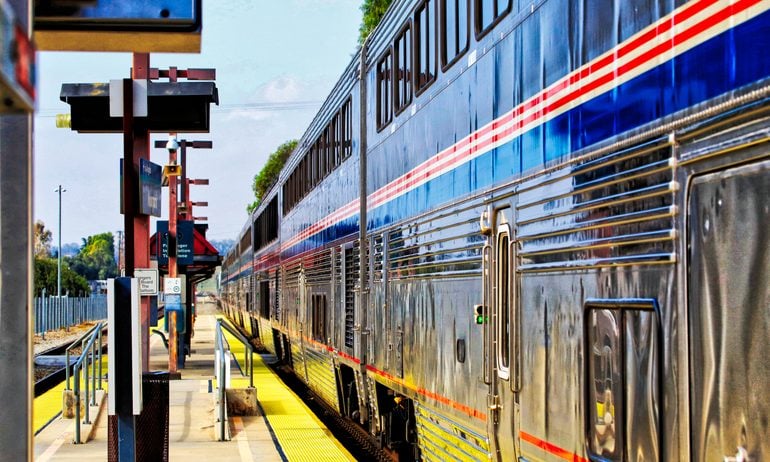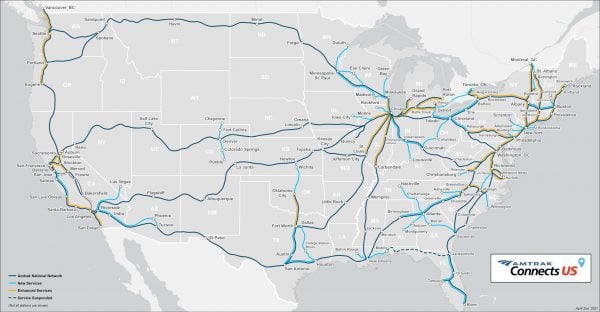Amtrak Expansion: Here’s What Train Travel Could Look Like Under the Infrastructure Bill
The $1 trillion infrastructure bill would allocate $66 billion to Amtrak, which has proposed 39 new routes by 2035.

Many or all of the products on this page are from partners who compensate us when you click to or take an action on their website, but this does not influence our evaluations or ratings. Our opinions are our own.
President Joe Biden is set to sign a $1 trillion infrastructure bill that was passed by the House late Friday. The bill is intended to invest in many aspects of American infrastructure, ranging from rebuilding rural bridges to reducing the climate change impacts of some transportation systems.
One entity that’s getting a significant chunk of funding is national rail operator Amtrak, which is set to get about $66 billion in infrastructure spending. That’s the largest investment in passenger rail since the creation of Amtrak about 50 years ago.
Funding will be dispersed across multiple Amtrak-related activities, including eliminating the Amtrak maintenance backlog and modernizing the popular Northeast Corridor. There’s also been funding allocated to establish new — or expand on existing — intercity passenger rail service to areas outside of the northeast and mid-Atlantic, where Amtrak currently tends to dominate.
» Learn more: How to Get Cheap Amtrak Tickets
Expanded routes
Amtrak CEO William Flynn appeared on HBO's "Axios" to discuss the bill. On the show, he listed routes where service is minimal or nonexistent, saying he hopes to see those expanded.
Among the cities he named that might see new or improved Amtrak service:
Phoenix to Tucson, Arizona: The trip currently takes about 4 hours on public transportation and 2 hours by car.
Cleveland to Columbus to Cincinnati, Ohio: The trip currently takes 7-10 hours on public transportation and 4 hours by car.
Los Angeles to Las Vegas: The trip currently takes about 6 hours on public transportation and 4 hours by car.
Some existing Amtrak routes have travel times roughly similar to the estimated driving time, so a streamlined rail service could offer a significant improvement.
For example, both driving and riding the rail between New York City and Washington, D.C., require about four hours of transit time. But when you ride the train, you don’t have the stress of sitting in traffic. Plus, you can typically buy food, and you can use the restroom without having to make a pit stop. With onboard Wi-Fi, which is typically free, you may be able to do your online job from right there on the train, meaning no need for time off.

A map of proposed rail service as outlined in the Amtrak Corridor Vision. Released by Amtrak in spring 2021.
Just don’t expect new routes to arrive anytime soon. Earlier this year, Amtrak released its Amtrak Corridor Vision, which included 39 potential new routes, including those mentioned by Flynn. Under that proposal, all of those routes wouldn’t be in place until 2035.
» Learn more: Credit Cards Can Help You Save on Buses and Trains, Too
Upgraded passenger experience
The news comes as many Americans are still wary of hopping on an airplane. COVID-19 safety concerns aside, air travel has been chaotic lately, with numerous delays and cancellations disrupting thousands of passengers in a few-day span. And with gas prices hovering around record highs, coupled with an ongoing rental car shortage, road trips might not be appealing, either.
While the new proposed routes won’t arrive for years, the infrastructure bill could have more immediate effects, including making existing routes more convenient to your schedule or improving your Amtrak experience on board.
“Amtrak passengers will see newly refurbished train interiors and brand new train sets; expanded and upgraded train stations and platforms; additional frequencies that offer more convenient travel options and connections; and new energy-efficient locomotives,” according to a statement from the Rail Passengers Association, which supported the bipartisan infrastructure bill.
That might be enough to entice passengers to come back, which many have yet to do. Ridership from January to July 2021 was just 8.8 million, which is 6.8 million lower (and $530.3 million less) than the same period in 2020. Amtrak attributed this decrease in revenue and ridership to the COVID-19 pandemic (though much of that same period in 2020 was also impacted by the pandemic).
That said, Amtrak has never been profitable in its roughly 50-year history.
» Learn more: The NerdWallet Guide to Amtrak Guest Rewards
Better infrastructure
The Rail Passengers Association said that even new bridges, rebuilt tunnels and upgraded signals could help bring back riders.
“Passengers will also benefit from the less glamorous upgrades to our aging rail infrastructure that will eliminate delays, add capacity and reduce trip-times.”
Chase Sapphire Preferred® Card
Travel
Dining
🔥 Huge highest-ever bonus on NerdWallet's 2025 Best All-Purpose Travel Rewards Card is back. Don't miss your rare chance to: Earn 100,000 points when you spend $5,000 on purchases in the first three months. That's worth at least $1,250 toward travel booked through Chase.


